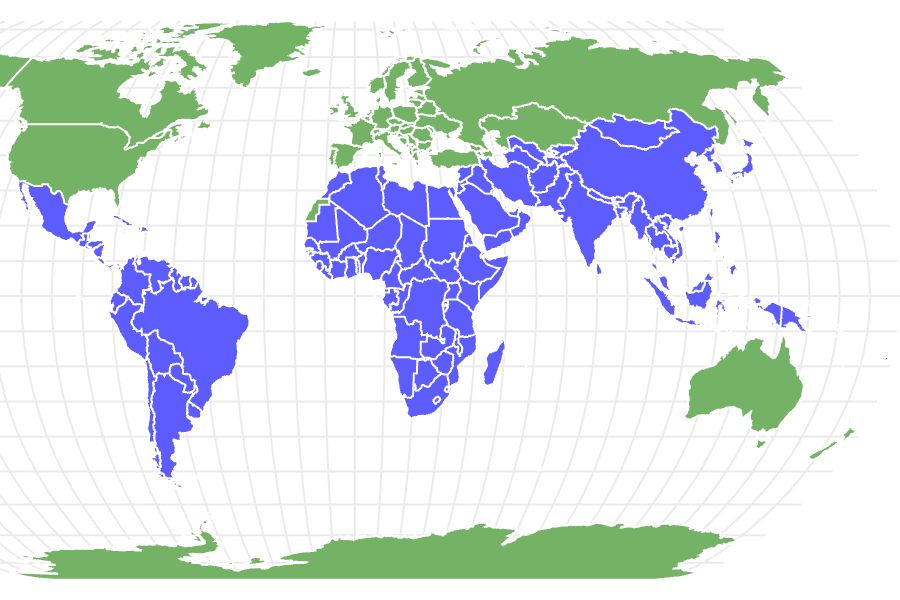Monkey
Macaca Fascicularis
There are around 260 known species!
Advertisement
Monkey Scientific Classification
- Kingdom
- Animalia
- Phylum
- Chordata
- Class
- Mammalia
- Order
- Primates
- Family
- Cebidae
- Scientific Name
- Macaca Fascicularis
Read our Complete Guide to Classification of Animals.
Monkey Conservation Status
Monkey Facts
- Main Prey
- Fruit, Seeds, Insects
- Habitat
- Tropical forests, grasslands and mountainous plains
- Predators
- Birds, Snakes, Wildcats
- Diet
- Omnivore
- Average Litter Size
- 1
View all of the Monkey images!
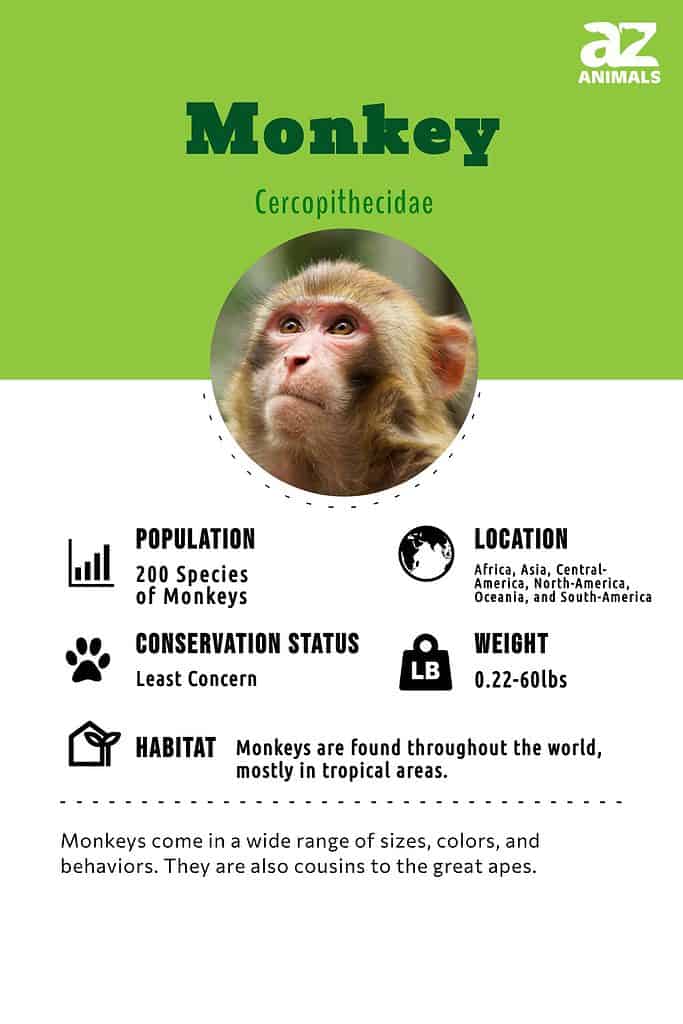
Monkeys are primates that comprise a wide range of species throughout much of the tropical world. Despite their raw variety, most of them face threats from human development, capture, and hunting. Though all monkeys have many similar characteristics and a close relationship to humans, an early evolutionary shift created two major groups today: “old” and “new” world monkeys.
Though they don’t walk on two legs, monkeys are closely related to humans–only great apes, such as chimpanzees, are more related. Monkeys are some of the most popular animals in the world.
6 Top Monkey facts

Monkeys at risk: out of over 250 species, only one type of monkey was listed as being of “least concern” for extinction.
©Blueton/Shutterstock.com
- Monkeys at risk: out of over 250 species, only one type of monkey was listed as being of “least concern” for extinction!
- Born tree: some monkeys can swing through branches as fast as a racehorse!
- Hanging out: Unlike their cousins, the apes, monkeys often have long tails–but only new world monkeys can use them to hang!
- Pocket-sized: the world’s smallest monkey, the pygmy marmoset, is less than six inches long and weighs less than a pack of playing cards!
- Mega-sized: the world’s largest monkeys can reach significant sizes. For example, male mandrills have reached 119 pounds in size!
- While the thought of a pet monkey may seem nice, they are illegal to own in most states.
Evolution and Origins
Most research suggests that monkeys evolved from prosimians during the Oligocene Epoch. Additionally, apes then evolved from catarrhines in Africa during the Miocene Epoch. With that said, scientists decided that apes should be divided into the lesser apes and the greater apes.
Studies also suggest that the ancestors of monkeys originated in Africa and the first known group is thought to have reached South America 40 million years ago. This happened when the land masses were closer together and made migration easier than it is today. As of today, the oldest known monkey skeleton is Canaanimico amazonensis. The skeleton has been dated to 26.5 million years ago.
Scientific name
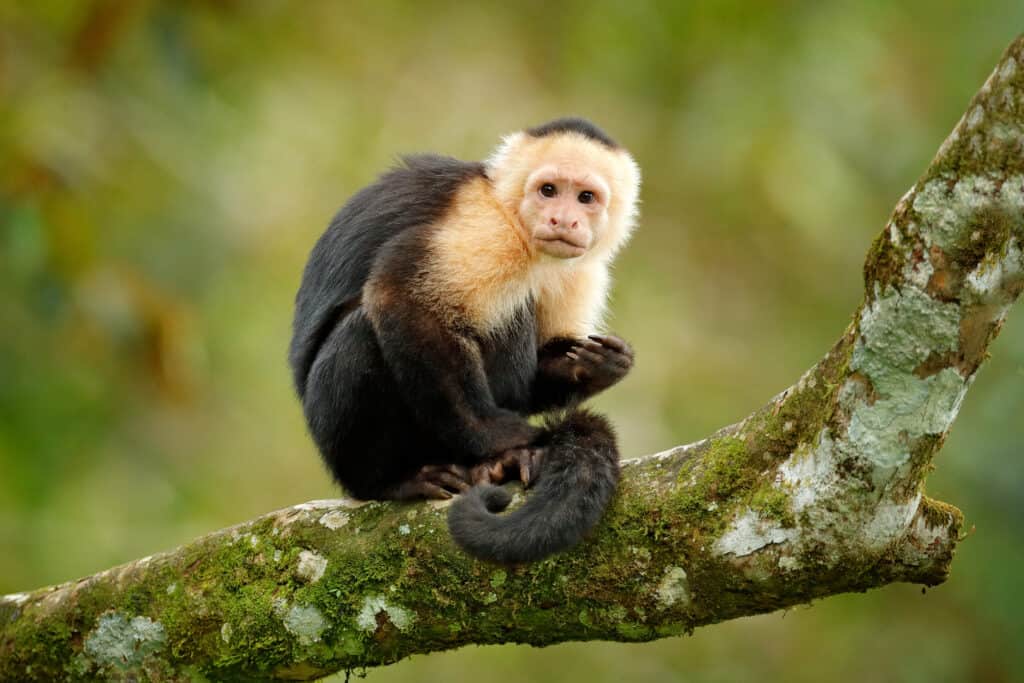
Monkeys fall under two scientific names:
simiiformes catarrhiniand
simiiformes platyrrhini.
©Ondrej Prosicky/Shutterstock.com
Monkeys fall under two scientific names: simiiformes catarrhini and simiiformes platyrrhini. Simiiformes, from which the word “simian” is derived, come from the Latin “simia” for ape or monkey. Catarrhini comes from the Latin for “hook-nosed,” likely a reference to the closer, downward-pointed nostrils of these monkeys. This is in contrast to Platyrrhini, which comes from the Latin word for “broad-nosed,” a reference to the more flattened nostrils of this class of monkeys.
Types of Monkeys
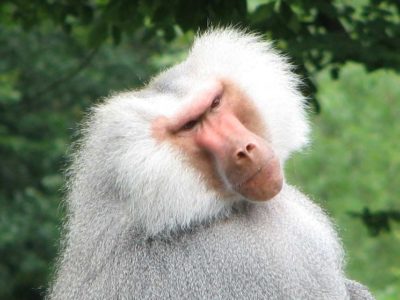
Baboon
Can travel more than four miles a day!

Cotton-top Tamarin
Found in tropical forest edges!
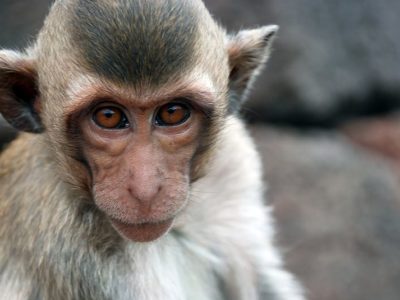
Crab-Eating Macaque
Found throughout the South-East Asian jungles!

De Brazza’s Monkey
They forage on plants and fruits and act as seed dispersers, helping their environment.
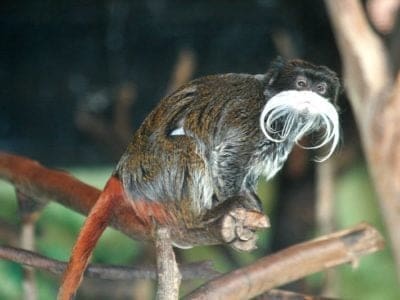
Emperor Tamarin
Has an elegant white moustache!

Geoffroys Tamarin
Has distinctive V shape on head!
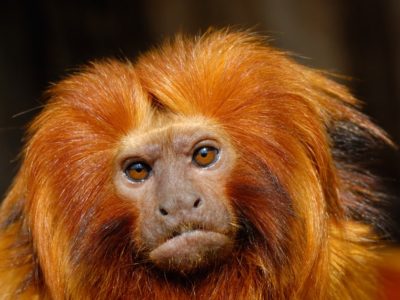
Golden Lion Tamarin
Native to the eastern rainforests of Brazil!

Howler Monkey
Spends 80% of it's time resting!

Japanese Macaque
Has cheek pouches for storing food!

Mandrill
Distinctively coloured noses and rumps!
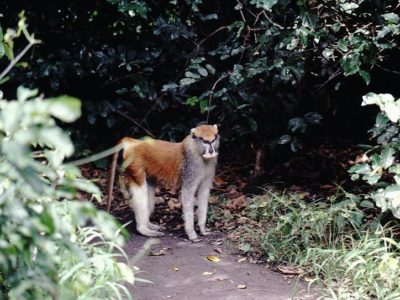
Patas Monkey
The fastest species of primate in the world!
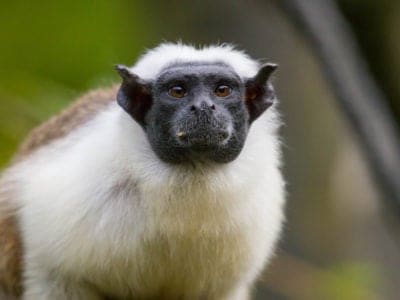
Pied Tamarin
Only found in one area of Brazil!
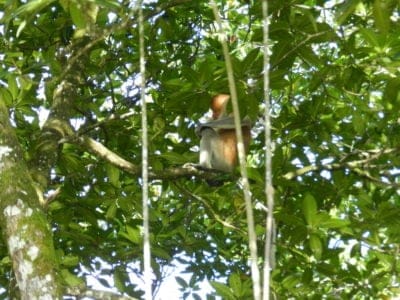
Proboscis Monkey
Natively found on the island of Borneo!

Red-handed Tamarin
Red hair on hands on feet!

Spider Monkey
Belongs to the only family of primates in the world with full prehensile tails!
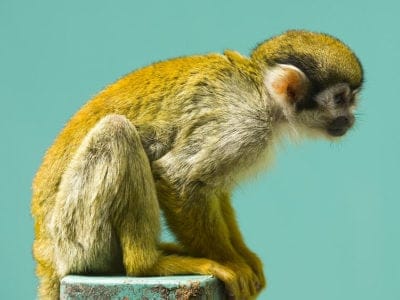
Squirrel Monkey
Lives in groups of up to 500 individuals!

Tamarin
These tiny yet intelligent monkeys often give birth to fraternal twins.
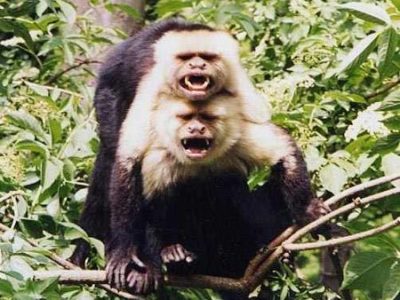
White-Faced Capuchin
One of the world's most intelligent monkeys!
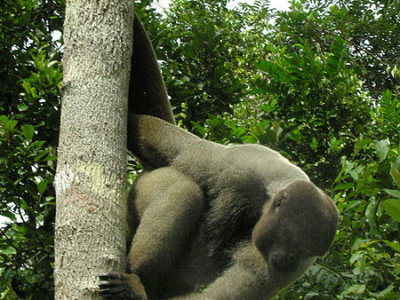
Woolly Monkey
Has a long, strong prehensile tail!
Appearance and behavior

Monkeys come in a wide range of sizes, colors, and behaviors.
©Gabi Siebenhuehner/Shutterstock.com
Monkeys are something of a cousin to apes. Great apes-including chimpanzees, gorillas, and orangutans–have larger brains and no tails. There exist over 250 species of monkeys, including macaques, tamarinds, and marmosets. Monkeys come in a wide range of sizes, colors, and behaviors. These range from the pygmy marmoset, which is less than six inches tall and weighs about as much as a deck of playing cards, to the colorful-nosed mandrill, which can weigh over 100 pounds and top out at over three feet long.
Overall, monkeys fall into two broad categories of appearance. Old World monkeys, or simiiformes catarrhini, mostly have more forward-facing noses, similar to humans. Virtually all catarrhini have tails, though none of them are prehensile, meaning they cannot use them to grab objects such as tree branches. The baboon is one example of an old-world group of monkeys, with long snouts and gray, brown, or tan fur that gets long around the chest and head. The tail of the baboon is approximately five inches long.
New World monkeys, simiiformes platyrrhini, have flatter noses with nostrils that face more to the sides. They are also the only type of monkeys that feature prehensile tails, meaning they can use their tails to grab objects and hang from trees. One common example of a platyrrhini is the spider monkey, which has a pink face poking out of noticeably long black fur.
Many monkeys avoid traveling on the ground, moving by way of what scientists call “brachiation.” Brachiation means moving around by swinging from one branch to another. Many monkeys, such as the spider monkey, have adapted long arms relative to their body for this purpose.
This, in addition to their prehensile tail, allows them to reach far for the next branch. Brachiation isn’t slow, either–some gibbons can move through the branches as fast as 34 miles per hour, the same speed as a racehorse.
Check out the most beautiful monkeys in the world and the ugliest monkeys in the world. Also, find out if monkeys can actually swim.
Habitat
Monkeys are found throughout the world, mostly in tropical areas. Catarrhini is found in Africa and Asia, while platyrrhinic mostly call Central and South America home. Most monkeys live in tropical areas, particularly in forests. Monkeys do, however, vary in the types of environments in which they thrive. Baboons, for example, live in places that are arider, or dry, in the southern countries of Africa, where it can also get cooler.
The Japanese macaque, covered in thick white-ish hair, is one of the northernmost surviving monkeys, living where there can be snow for months in parts of northern Japan. Some of them do so by relaxing in hot mountain springs.
Meanwhile, the golden-headed lion tamarin lives in a low area of Brazil, where there’s lots of rain and the average temperature is over 80 degrees Fahrenheit. The lion tamarin also spends its life in the trees, specifically between 10 and 30 feet off the ground, while a baboon will usually only go to high places, such as cliffs, to sleep and get away from predators.
Diet
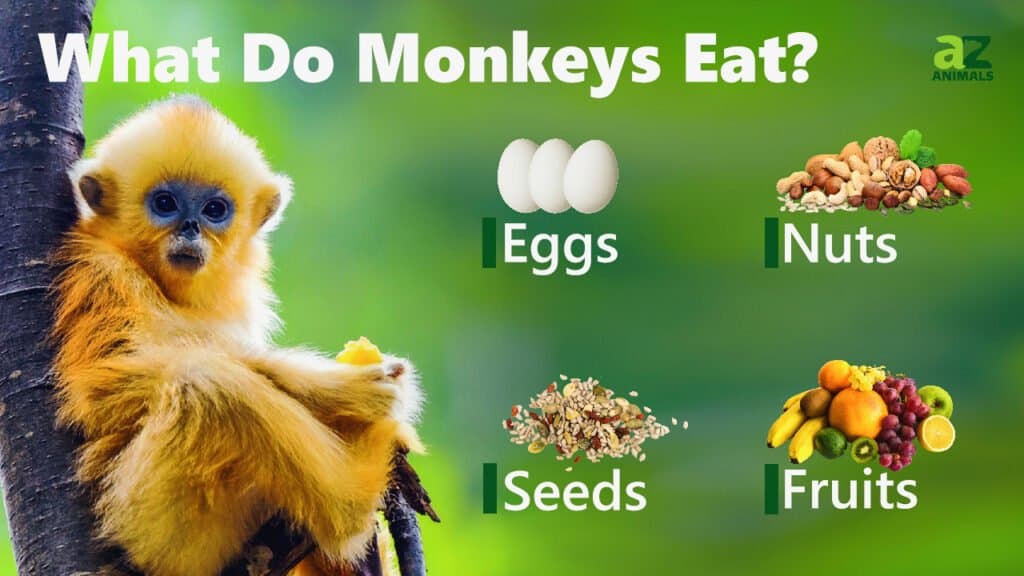
Most monkeys are omnivores, which means they eat a combination of meat and plants. Because of their size, the majority of monkeys get their “meat” from insects or grubs. Larger monkeys will also eat larger prey, such as lizards, or steal bird eggs. Fruit, nuts, and seeds also form a large part of most monkeys’ diets. It is a common conception that monkeys eat bananas, but you can find out if monkeys really eat bananas in this article.
The amount of meat or plants eaten by a monkey depends on their environment as well as the time of the year. Monkeys might feast on grubs during those insects’ breeding times or eat lots of fruit while it is ripe, then resort to more dependable food for the rest of the year. The squirrel monkey, for example, gets three-quarters of its nutrition from insects, but will mostly eat plants and fruits, particularly from the Attalea maripa palms, during the rainy season.
For a complete list of the food monkeys eats, check out our “What Do Monkeys Eat” page.
Predators and threats
Monkeys across the world face dangers from other animals as well as humans. In Africa particularly, larger predators such as lions will attempt to hunt monkeys. However, the biggest threat to most monkeys comes from humans.
Humans threaten monkeys through hunting and development. Farmers and loggers can damage a species of monkey’s ecosystem, even when humans clear out a small area. The clearing of trees for crops or lumber can disrupt the ways in which the monkey searches for food for example. In addition, some regions allow monkeys to be hunted for food or captured for sale as pets.
Reproduction, babies, and lifespan
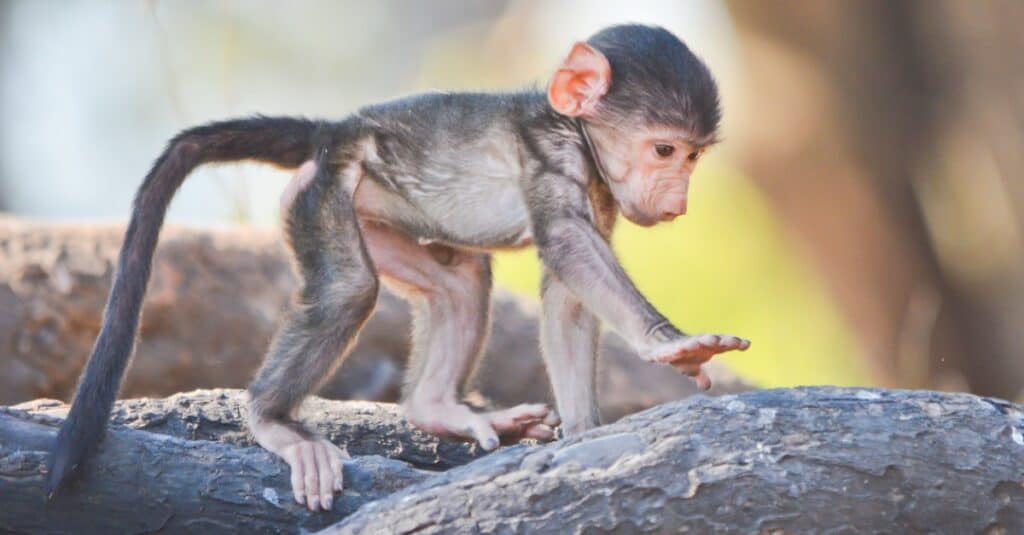
Monkeys give live birth to one or two babies at a time.
©iStock.com/marcelauret
Much like humans, monkeys give live birth to one or two babies at a time and live long lives compared to other mammals. Though smaller monkeys can have life spans more like a household pet–around 15 years, on average, for many tamarinds–larger monkeys can live as long as 35 years in the wild. Monkeys live even longer in captivity, including one bornean gibbon that made it to 60 years old.
Monkeys grow to maturity within a few years, overall. Like humans, it can take about a year for a fertile female to mate and give live birth to a baby monkey. These timelines are typically shorter for smaller, more rodent-sized monkeys. Like humans, monkeys often have a near-monthly cycle where they can get pregnant. Despite this, most monkey species have a mating season that revolves around food availability.
Most monkey species will give birth to a new baby approximately once every year. Monkey mothers will typically nurse and care for a newborn monkey for at least a few months until the baby monkey becomes more independent. During this time, the baby monkey might cling to the mother exclusively, preventing the mother from having another baby.
Many monkey species form family groups with many adult females and an “alpha” male with whom most of the females mate. Non-alpha males born into these groups might separate from the group in adulthood to form their own family group. As the alpha male grows older or dies, another male may take over as the alpha.
Population
The number of monkeys around the world varies dramatically by species. Some are relatively abundant–such as the Bornean gibbon, of which there are hundreds of thousands estimated worldwide–while the Hainan black-crested gibbon is one of the rarest monkeys, with less than 30 alive in the world. Regardless of population, almost every monkey in the world is on the decline and is classified as “endangered” by conservation groups.
The black-crested gibbon, specifically, is listed as “critically endangered” by the International Union for the Conservation of Nature (IUCN). Other IUCN critically-endangered monkeys include the gray-headed lemur, the blond capuchin, the Myanmar snub-nosed monkey, and the Sarawak surili.
A few species of monkeys are defined as being only “vulnerable,” a category that is better than “endangered” under the IUCN rating. Vulnerable monkeys include the black-crowned dwarf marmoset and the Natuna Island surili.
The gelada, a type of baboon found in Ethiopia, is one of the only monkeys to earn the IUCN “Least Concern” ranking.
Monkey FAQs (Frequently Asked Questions)
Are monkeys dangerous?
Monkeys can be dangerous as pets, transmitting disease and giving nasty bites, but the risk is relatively small. From 1990 to 2013, the Humane Society had documented 275 attacks from “captive primates” in the U.S., none of which caused death. The majority of monkeys in the wild are shy, preferring to hide from humans rather than confront them.
Can you have a monkey as a pet?
Caring for a monkey is complicated, and a number of states in the U.S. and other countries prohibit or limit who can own a monkey. For example, Alabama allows monkeys as pets; New Hampshire bans monkeys as pets; and Idaho allows monkey ownership, provided you have a special permit.
Are chimpanzees monkeys?
Chimpanzees are actually part of a separate classification of primates, called “great apes.” Great apes are a small group of primates that share many features with monkeys, but are larger, smarter and tail-less. Great apes also share a closer genetic connection to humans. The chimpanzees, particularly, are humans’ closest genetic relative, sharing 99 percent of our genetic code!
Are Monkeys herbivores, carnivores, or omnivores?
Monkeys are Omnivores, meaning they eat both plants and other animals.
What Kingdom do Monkeys belong to?
Monkeys belong to the Kingdom Animalia.
What phylum do Monkeys belong to?
Monkeys belong to the phylum Chordata.
What class do Monkeys belong to?
Monkeys belong to the class Mammalia.
What family do Monkeys belong to?
Monkeys belong to the family Cebidae.
What order do Monkeys belong to?
Monkeys belong to the order Primates.
What type of covering do Monkeys have?
Monkeys are covered in Hair.
In what type of habitat do Monkeys live?
Monkeys live in tropical forests, grasslands, and mountainous plains.
What do Monkeys eat?
Monkeys eat fruit, seeds, and insects.
What are some predators of Monkeys?
Predators of Monkeys include birds, snakes, and wildcats.
What is the average litter size for a Monkey?
The average litter size for a Monkey is 1.
What is an interesting fact about Monkeys?
There are around 260 known Monkey species!
What is the scientific name for the Monkey?
The scientific name for the Monkey is Macaca Fascicularis.
What is the lifespan of a Monkey?
Monkeys can live for 10 to 30 years.
How fast is a Monkey?
A Monkey can travel at speeds of up to 35 miles per hour.
What is the difference between a chimpanzee and a monkey?
The main differences between a monkey and a chimpanzee include their family type, appearance, diet, intelligence, and ways of communication.
What are the key differences between gorillas and monkeys?
The key differences between gorillas and monkeys are classification within the primate order, diet, and size.
What are the differences between apes and monkeys?
The key differences between apes and monkeys are intelligence and tails. Other differences include location, joints, size, joints, and movements.
Thank you for reading! Have some feedback for us? Contact the AZ Animals editorial team.
Sources
- David Burnie, Dorling Kindersley (2011) Animal, The Definitive Visual Guide To The World's Wildlife
- Tom Jackson, Lorenz Books (2007) The World Encyclopedia Of Animals
- David Burnie, Kingfisher (2011) The Kingfisher Animal Encyclopedia
- Richard Mackay, University of California Press (2009) The Atlas Of Endangered Species
- David Burnie, Dorling Kindersley (2008) Illustrated Encyclopedia Of Animals
- Dorling Kindersley (2006) Dorling Kindersley Encyclopedia Of Animals
- David W. Macdonald, Oxford University Press (2010) The Encyclopedia Of Mammals

